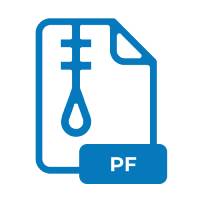.PF File Extension

Private File
| Developer | Smith Micro |
| Popularity | |
| Category | Compressed Files |
| Format | .PF |
| Cross Platform | Update Soon |
What is an PF file?
.PF (Private File) is a file extension used to denote private or encrypted files. These files are designed to secure sensitive information by employing encryption techniques, ensuring that only authorized users can access their contents. The .PF extension indicates that the file has undergone encryption to maintain confidentiality and integrity.
More Information.
The .PF file extension’s history is intertwined with the evolution of encryption technologies and the growing need for privacy and security in digital environments. Initially, encryption tools emerged primarily for securing sensitive data in corporate and governmental settings. However, as digital privacy concerns expanded to encompass personal information, encryption became more prevalent across various user demographics.
The initial purpose of .PF files was to provide a secure means of storing and transmitting sensitive data. These files offer protection against unauthorized access, ensuring that only individuals with the appropriate decryption key or access credentials can view or modify the contents. As privacy concerns continue to intensify in an interconnected world, the use of encrypted file formats like .PF remains vital for safeguarding sensitive information.
Origin Of This File.
The origin of the .PF file extension is not universally attributed to a specific developer or organization. Rather, it’s often used generically to signify files that have undergone encryption for privacy or security purposes. Various software applications and encryption tools may utilize the .PF extension to denote encrypted files, making their origins diverse and dispersed across different developers and contexts.
File Structure Technical Specification.
.PF files typically consist of encrypted data, rendering their contents inaccessible without the decryption key or proper authentication. The specific file structure and technical specifications can vary depending on the encryption algorithm and software used to create the .PF file. However, common characteristics may include:
- Encrypted data using symmetric or asymmetric encryption algorithms.
- Metadata containing information about the encryption method, key management, and other relevant details.
- File headers or markers to indicate the beginning and end of encrypted segments.
- Optional features such as compression or additional layers of security.
The technical specifications of .PF files are largely determined by the encryption software or platform utilized, with various implementations offering different levels of security and compatibility.
How to Convert the File?
Windows:
- Install Encryption Software: Begin by installing encryption software that supports .PF file decryption on your Windows computer. Popular options include VeraCrypt, AxCrypt, or BitLocker.
- Open Encryption Software: Launch the installed encryption software and navigate to the decryption or file conversion feature. This may vary depending on the specific software you’re using.
- Select .PF File: Choose the .PF file you wish to convert by browsing through your computer’s file directory within the encryption software.
- Decrypt File: Follow the on-screen instructions provided by the encryption software to decrypt the .PF file. You may need to enter the decryption key or credentials associated with the file.
- Save Converted File: Once decryption is complete, the .PF file will be converted into its original format or a readable format based on your preferences. Save the converted file to your desired location on your Windows computer.
- Verify Conversion: Ensure that the converted file opens correctly and contains the expected content before proceeding further.
Linux:
- Install Encryption Software: Install encryption software compatible with Linux distributions. Common options include GnuPG, OpenSSL, or EncFS.
- Access Terminal: Open a terminal window on your Linux system.
- Decrypt .PF File: Use the command-line interface of the installed encryption software to decrypt the .PF file. The exact command may vary depending on the software you’re using. For example, with GnuPG, you can use the command
gpg --decrypt filename.pf. - Enter Decryption Key: If prompted, enter the decryption key or credentials required to decrypt the .PF file.
- Save Converted File: Once decryption is complete, the .PF file will be converted into its original or readable format. Save the converted file to your desired location on your Linux system.
- Verify Conversion: Verify that the converted file opens correctly and contains the expected content using appropriate applications or tools on your Linux system.
Mac:
- Install Encryption Software: Install encryption software compatible with macOS, such as VeraCrypt, GPG Suite, or FileVault.
- Open Encryption Software: Launch the installed encryption software on your Mac.
- Import .PF File: Import the .PF file you wish to convert into the encryption software. This can usually be done by selecting the file through the software’s interface.
- Decrypt File: Follow the decryption instructions provided by the encryption software to decrypt the .PF file. You may need to enter the decryption key or credentials associated with the file.
- Save Converted File: Once decryption is complete, the .PF file will be converted into its original or readable format. Save the converted file to your desired location on your Mac.
- Verify Conversion: Make sure to verify that the converted file opens correctly and contains the expected content using appropriate applications on your Mac.
Android:
- Install File Decryption App: Visit the Google Play Store on your Android device and search for a file decryption app that supports .PF files. Examples include Andrognito, FileCrypt, or EasyCrypt.
- Download and Install: Download and install the chosen file decryption app onto your Android device.
- Open App: Launch the file decryption app on your Android device.
- Import .PF File: Import the .PF file you wish to convert into the decryption app. This can usually be done by browsing through your device’s file directory within the app.
- Decrypt File: Follow the decryption instructions provided by the app to decrypt the .PF file. You may need to enter the decryption key or credentials associated with the file.
- Save Converted File: Once decryption is complete, the .PF file will be converted into its original or readable format. Save the converted file to your desired location on your Android device.
iOS:
- Install File Decryption App: Go to the App Store on your iOS device and search for a file decryption app that supports .PF files. Examples include Cryptomator, Secure Filebox, or Kyms.
- Download and Install: Download and install the chosen file decryption app onto your iOS device.
- Open App: Launch the file decryption app on your iOS device.
- Import .PF File: Import the .PF file you wish to convert into the decryption app. This can usually be done by browsing through your device’s file directory within the app.
- Decrypt File: Follow the decryption instructions provided by the app to decrypt the .PF file. You may need to enter the decryption key or credentials associated with the file.
- Save Converted File: Once decryption is complete, the .PF file will be converted into its original or readable format. Save the converted file to your desired location on your iOS device.
Advantages And Disadvantages.
Advantages:
- Enhanced security: .PF files provide robust encryption mechanisms to protect sensitive data from unauthorized access.
- Privacy assurance: Users can securely store and transmit confidential information without fear of interception or compromise.
- Compliance adherence: .PF files help organizations comply with data protection regulations and privacy standards by safeguarding sensitive data.
Disadvantages:
- Dependency on decryption keys: Loss or compromise of decryption keys can result in permanent data loss or unauthorized access to sensitive information.
- Compatibility limitations: .PF files may require specific software or tools for decryption, limiting their accessibility across different platforms or environments.
- Complexity: Managing encryption keys and securely transmitting .PF files can be challenging, particularly for users with limited technical expertise.
How to Open PF?
Open In Windows
- Install compatible encryption software that supports .PF file decryption.
- Use the software’s decryption feature to convert .PF files into readable formats.
Open In Linux
- Utilize encryption software with Linux compatibility to decrypt .PF files.
- Follow the decryption instructions provided by the software to convert .PF files.
Open In MAC
- Install encryption software compatible with macOS to decrypt .PF files.
- Use the decryption functionality within the software to convert .PF files into readable formats.
Open In Android
- Install an Android app capable of decrypting .PF files.
- Follow the decryption process outlined within the app to convert .PF files.
Open In IOS
- Install an iOS app designed for decrypting .PF files.
- Use the decryption feature within the app to convert .PF files into readable formats.
Open in Others
- For other operating systems or environments, utilize encryption software with cross-platform compatibility.
- Follow the decryption instructions provided by the software to convert .PF files accordingly.













